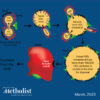As climate change progresses, the chance of southern plant species spreading to northern regions increases. In Europe and America, many of the alien plant species come from their own continent. They usually originate in warmer regions closer to the equator—a phenomenon that could be exacerbated by climate change.
This is the conclusion reached by an international research team led by the University of Konstanz and with the participation of biodiversity researchers Franz Essl and Bernd Lenzner from the University of Vienna. The study was recently published in the journal Science Advances.
If people spread plant or animal species beyond their natural range, it can have serious ecological consequences in the newly populated areas—for example, native species are displaced by the newcomers and the existing ecosystem is thrown out of balance. This ecological damage caused by the loss of native biodiversity also results in immense economic damage, which the World Biodiversity Council estimated in its current report (2023) at at least 400 billion dollars (371 billion euros)—per year.
Many people initially think of alien plants or animals as species from overseas that are intended to cross the oceans for economic interest or as “stowaways.” However, using the examples of Europe, Australia and North and South America, an international research team led by the Konstanz biologist Mark van Kleunen shows that these only make up part of this problem.
In their study in Science Advances, the researchers were able to prove that on the continents under consideration, more than half (57%) of the alien plant species that have successfully established themselves in new areas originally came from their own continent. The proportions were particularly high in Europe and North America. However, the proportion was noticeably low in Australia.
Recurring patterns in dispersal within a continent
For Europe, North and South America—the scientists also found similarities in the spread patterns: In the majority of cases, the spread within a continent occurred from the regions near the equator towards the respective poles. “In this work, we were able to show that not only are native species increasingly migrating northwards, but alien species are also predominantly being spread northwards by humans,” explains Franz Essl.
In their study, the scientists also examined the role that human, climatic and geographical factors play in the intracontinental spread of alien plants. They showed that long distances and strong climatic differences counteract spread. “The closer an area is to the original distribution area of a species and the more similar the climate is, the easier it is for alien species to colonize,” adds Bernd Lenzner.
Regarding the effects of climate change, the scientists conclude from their results that it will accelerate the intracontinental spread of alien plants. “The accelerating climate change will increasingly allow heat-loving alien species to settle. This can lead to significant negative consequences for biodiversity and the economy in the recipient regions,” says Essl.
More information:
Zhijie Zhang et al, The poleward naturalization of intracontinental alien plants, Science Advances (2023). DOI: 10.1126/sciadv.adi1897
Provided by
University of Vienna
Citation:
Non-native plants migrate north as climate change advances, study finds (2023, October 5)



